2017 CHEVROLET EXPRESS CARGO VAN cooling
[x] Cancel search: coolingPage 231 of 346
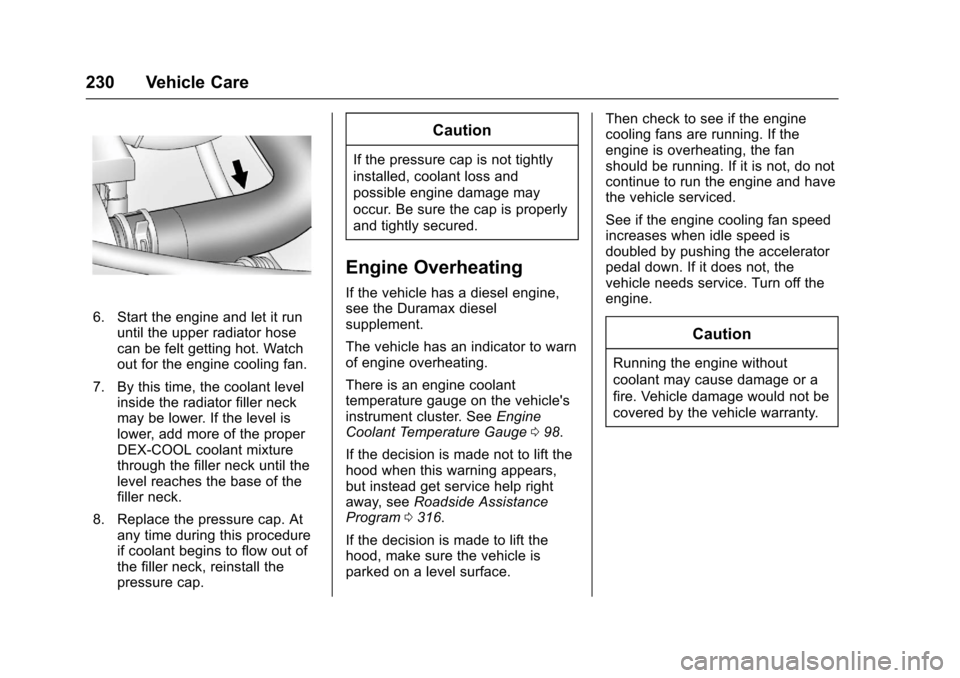
Chevrolet Express Owner Manual (GMNA-Localizing-U.S./Canada/Mexico-9967827) - 2017 - crc - 5/2/16
230 Vehicle Care
6. Start the engine and let it rununtil the upper radiator hosecan be felt getting hot. Watchout for the engine cooling fan.
7. By this time, the coolant levelinside the radiator filler neckmay be lower. If the level islower, add more of the properDEX-COOL coolant mixturethrough the filler neck until thelevel reaches the base of thefiller neck.
8. Replace the pressure cap. Atany time during this procedureif coolant begins to flow out ofthe filler neck, reinstall thepressure cap.
Caution
If the pressure cap is not tightly
installed, coolant loss and
possible engine damage may
occur. Be sure the cap is properly
and tightly secured.
Engine Overheating
If the vehicle has a diesel engine,see the Duramax dieselsupplement.
The vehicle has an indicator to warnof engine overheating.
There is an engine coolanttemperature gauge on the vehicle'sinstrument cluster. SeeEngineCoolant Temperature Gauge098.
If the decision is made not to lift thehood when this warning appears,but instead get service help rightaway, seeRoadside AssistanceProgram0316.
If the decision is made to lift thehood, make sure the vehicle isparked on a level surface.
Then check to see if the enginecooling fans are running. If theengine is overheating, the fanshould be running. If it is not, do notcontinue to run the engine and havethe vehicle serviced.
See if the engine cooling fan speedincreases when idle speed isdoubled by pushing the acceleratorpedal down. If it does not, thevehicle needs service. Turn off theengine.
Caution
Running the engine without
coolant may cause damage or a
fire. Vehicle damage would not be
covered by the vehicle warranty.
Page 232 of 346
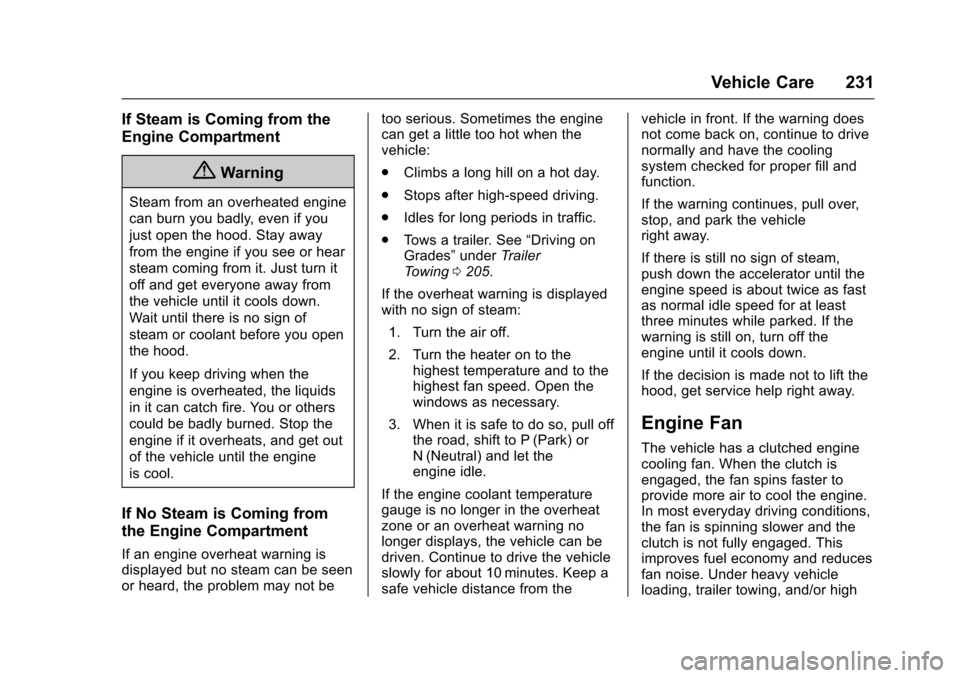
Chevrolet Express Owner Manual (GMNA-Localizing-U.S./Canada/Mexico-9967827) - 2017 - crc - 5/2/16
Vehicle Care 231
If Steam is Coming from the
Engine Compartment
{Warning
Steam from an overheated engine
can burn you badly, even if you
just open the hood. Stay away
from the engine if you see or hear
steam coming from it. Just turn it
off and get everyone away from
the vehicle until it cools down.
Wait until there is no sign of
steam or coolant before you open
the hood.
If you keep driving when the
engine is overheated, the liquids
in it can catch fire. You or others
could be badly burned. Stop the
engine if it overheats, and get out
of the vehicle until the engine
is cool.
If No Steam is Coming from
the Engine Compartment
If an engine overheat warning isdisplayed but no steam can be seenor heard, the problem may not be
too serious. Sometimes the enginecan get a little too hot when thevehicle:
.Climbs a long hill on a hot day.
.Stops after high-speed driving.
.Idles for long periods in traffic.
.To w s a t r a i l e r . S e e“Driving onGrades”underTr a i l e rTo w i n g0205.
If the overheat warning is displayedwith no sign of steam:
1. Turn the air off.
2. Turn the heater on to thehighest temperature and to thehighest fan speed. Open thewindows as necessary.
3. When it is safe to do so, pull offthe road, shift to P (Park) orN(Neutral) and let theengine idle.
If the engine coolant temperaturegauge is no longer in the overheatzone or an overheat warning nolonger displays, the vehicle can bedriven. Continue to drive the vehicleslowly for about 10 minutes. Keep asafe vehicle distance from the
vehicle in front. If the warning doesnot come back on, continue to drivenormally and have the coolingsystem checked for proper fill andfunction.
If the warning continues, pull over,stop, and park the vehicleright away.
If there is still no sign of steam,push down the accelerator until theengine speed is about twice as fastas normal idle speed for at leastthree minutes while parked. If thewarning is still on, turn off theengine until it cools down.
If the decision is made not to lift thehood, get service help right away.
Engine Fan
The vehicle has a clutched enginecooling fan. When the clutch isengaged, the fan spins faster toprovide more air to cool the engine.In most everyday driving conditions,the fan is spinning slower and theclutch is not fully engaged. Thisimproves fuel economy and reducesfan noise. Under heavy vehicleloading, trailer towing, and/or high
Page 233 of 346
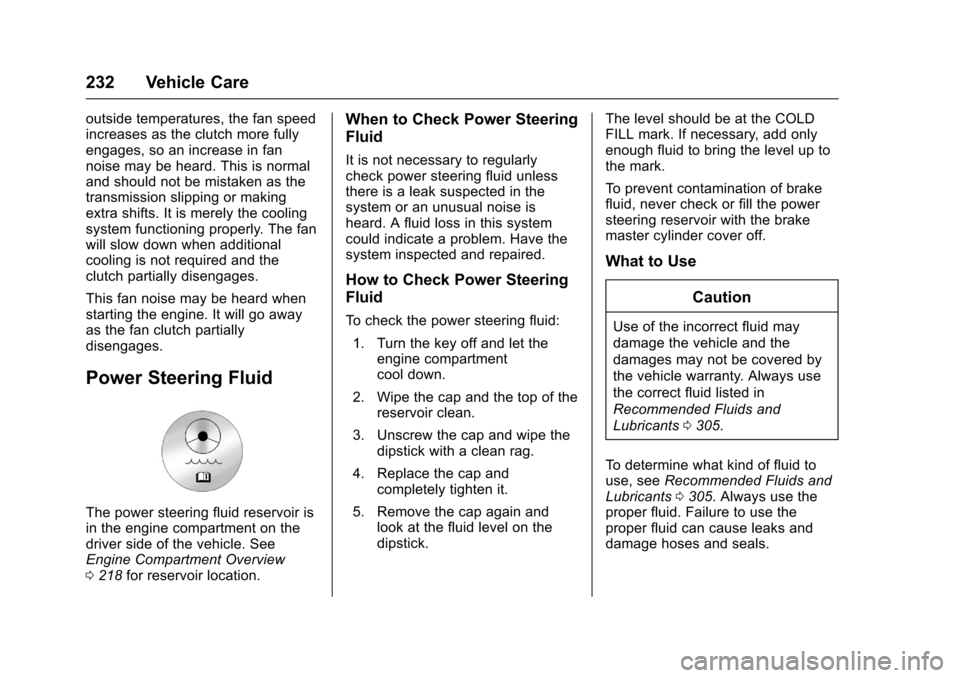
Chevrolet Express Owner Manual (GMNA-Localizing-U.S./Canada/Mexico-9967827) - 2017 - crc - 5/2/16
232 Vehicle Care
outside temperatures, the fan speedincreases as the clutch more fullyengages, so an increase in fannoise may be heard. This is normaland should not be mistaken as thetransmission slipping or makingextra shifts. It is merely the coolingsystem functioning properly. The fanwill slow down when additionalcooling is not required and theclutch partially disengages.
This fan noise may be heard whenstarting the engine. It will go awayas the fan clutch partiallydisengages.
Power Steering Fluid
The power steering fluid reservoir isin the engine compartment on thedriver side of the vehicle. SeeEngine Compartment Overview0218for reservoir location.
When to Check Power Steering
Fluid
It is not necessary to regularlycheck power steering fluid unlessthere is a leak suspected in thesystem or an unusual noise isheard. A fluid loss in this systemcould indicate a problem. Have thesystem inspected and repaired.
How to Check Power Steering
Fluid
To c h e c k t h e p o w e r s t e e r i n g f l u i d :
1. Turn the key off and let theengine compartmentcool down.
2. Wipe the cap and the top of thereservoir clean.
3. Unscrew the cap and wipe thedipstick with a clean rag.
4. Replace the cap andcompletely tighten it.
5. Remove the cap again andlook at the fluid level on thedipstick.
The level should be at the COLDFILL mark. If necessary, add onlyenough fluid to bring the level up tothe mark.
To p r e v e n t c o n t a m i n a t i o n o f b r a k efluid, never check or fill the powersteering reservoir with the brakemaster cylinder cover off.
What to Use
Caution
Use of the incorrect fluid may
damage the vehicle and the
damages may not be covered by
the vehicle warranty. Always use
the correct fluid listed in
Recommended Fluids and
Lubricants0305.
To d e t e r m i n e w h a t k i n d o f f l u i d t ouse, seeRecommended Fluids andLubricants0305.Alwaysusetheproper fluid. Failure to use theproper fluid can cause leaks anddamage hoses and seals.
Page 249 of 346
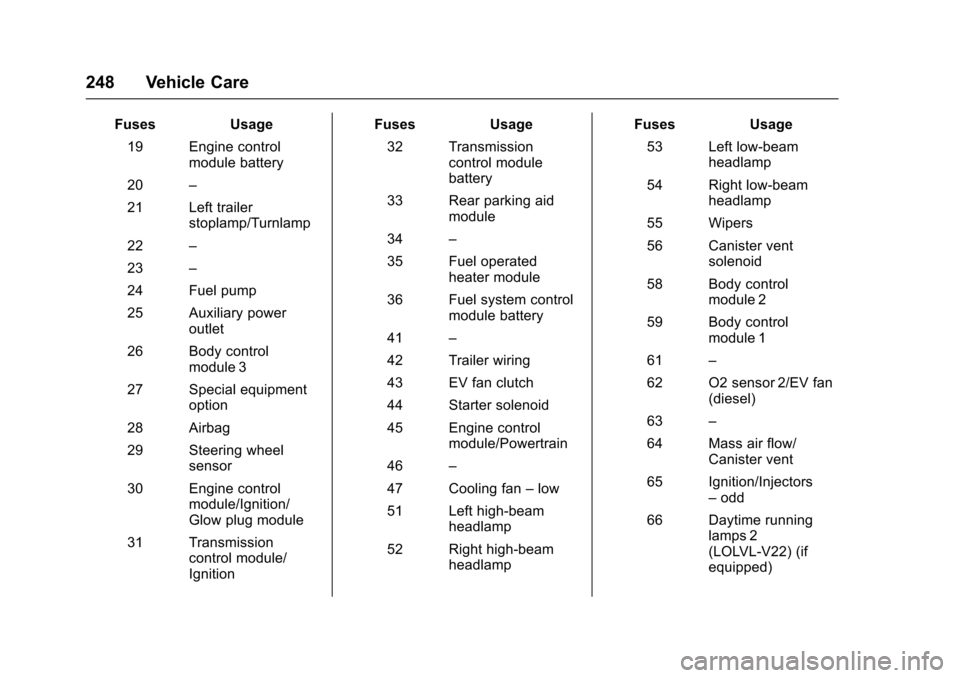
Chevrolet Express Owner Manual (GMNA-Localizing-U.S./Canada/Mexico-9967827) - 2017 - crc - 5/2/16
248 Vehicle Care
FusesUsage
19 Engine controlmodule battery
20–
21 Left trailerstoplamp/Turnlamp
22–
23–
24 Fuel pump
25 Auxiliary poweroutlet
26 Body controlmodule 3
27 Special equipmentoption
28 Airbag
29 Steering wheelsensor
30 Engine controlmodule/Ignition/Glow plug module
31 Transmissioncontrol module/Ignition
FusesUsage
32 Transmissioncontrol modulebattery
33 Rear parking aidmodule
34–
35 Fuel operatedheater module
36 Fuel system controlmodule battery
41–
42 Trailer wiring
43 EV fan clutch
44 Starter solenoid
45 Engine controlmodule/Powertrain
46–
47 Cooling fan–low
51 Left high-beamheadlamp
52 Right high-beamheadlamp
FusesUsage
53 Left low-beamheadlamp
54 Right low-beamheadlamp
55 Wipers
56 Canister ventsolenoid
58 Body controlmodule 2
59 Body controlmodule 1
61–
62 O2 sensor 2/EV fan(diesel)
63–
64 Mass air flow/Canister vent
65 Ignition/Injectors–odd
66 Daytime runninglamps 2(LOLVL-V22) (ifequipped)
Page 250 of 346
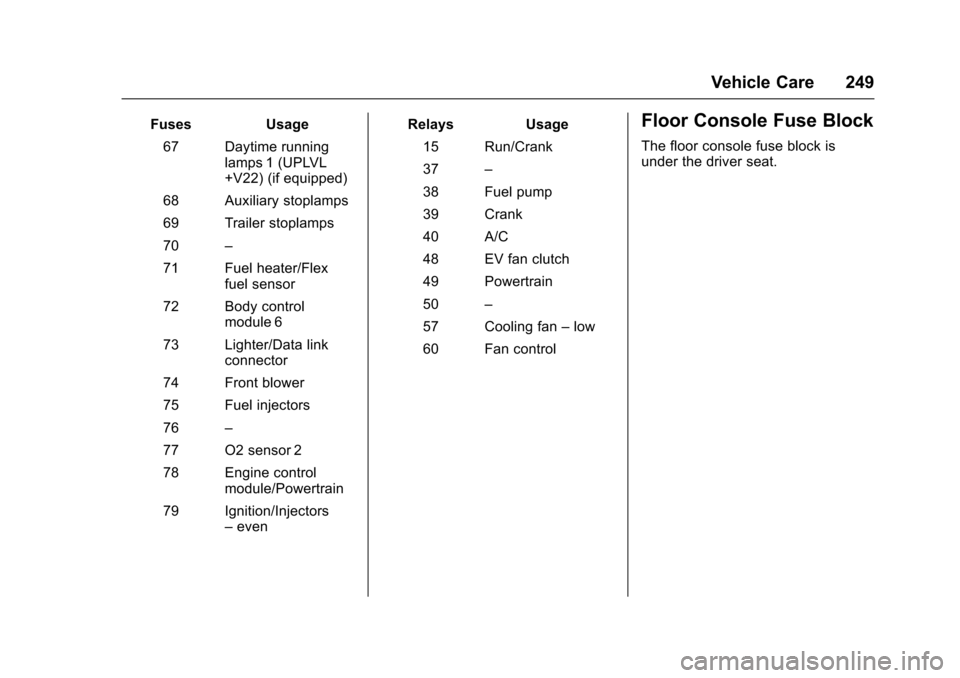
Chevrolet Express Owner Manual (GMNA-Localizing-U.S./Canada/Mexico-9967827) - 2017 - crc - 5/2/16
Vehicle Care 249
FusesUsage
67 Daytime runninglamps 1 (UPLVL+V22) (if equipped)
68 Auxiliary stoplamps
69 Trailer stoplamps
70–
71 Fuel heater/Flexfuel sensor
72 Body controlmodule 6
73 Lighter/Data linkconnector
74 Front blower
75 Fuel injectors
76–
77 O2 sensor 2
78 Engine controlmodule/Powertrain
79 Ignition/Injectors–even
RelaysUsage
15 Run/Crank
37–
38 Fuel pump
39 Crank
40 A/C
48 EV fan clutch
49 Powertrain
50–
57 Cooling fan–low
60 Fan control
Floor Console Fuse Block
The floor console fuse block isunder the driver seat.
Page 273 of 346
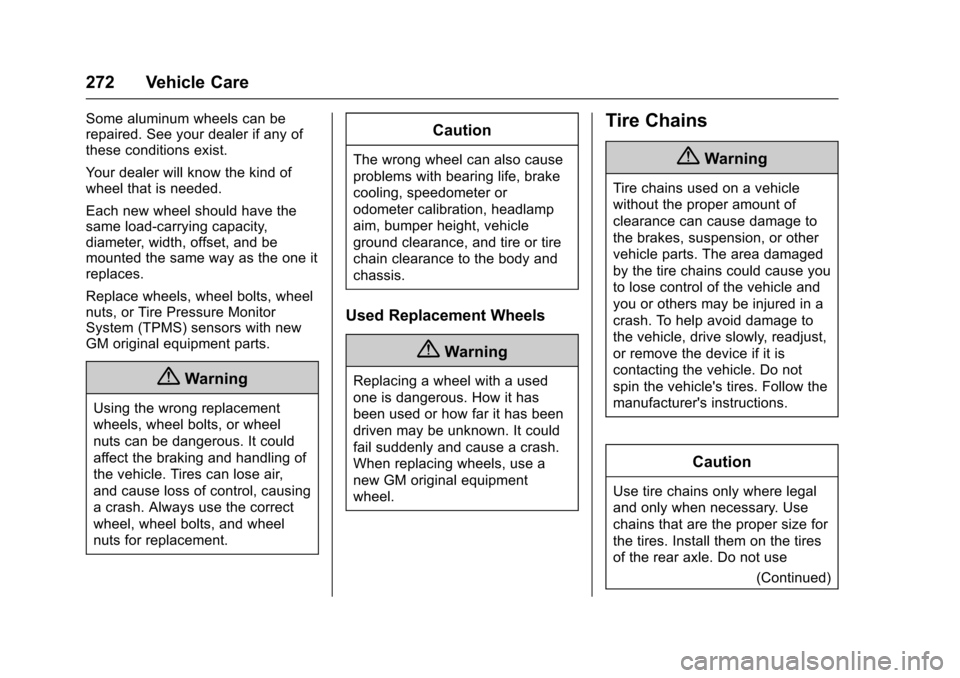
Chevrolet Express Owner Manual (GMNA-Localizing-U.S./Canada/Mexico-9967827) - 2017 - crc - 5/2/16
272 Vehicle Care
Some aluminum wheels can berepaired. See your dealer if any ofthese conditions exist.
Yo u r d e a l e r w i l l k n o w t h e k i n d o fwheel that is needed.
Each new wheel should have thesame load-carrying capacity,diameter, width, offset, and bemounted the same way as the one itreplaces.
Replace wheels, wheel bolts, wheelnuts, or Tire Pressure MonitorSystem (TPMS) sensors with newGM original equipment parts.
{Warning
Using the wrong replacement
wheels, wheel bolts, or wheel
nuts can be dangerous. It could
affect the braking and handling of
the vehicle. Tires can lose air,
and cause loss of control, causing
acrash.Alwaysusethecorrect
wheel, wheel bolts, and wheel
nuts for replacement.
Caution
The wrong wheel can also cause
problems with bearing life, brake
cooling, speedometer or
odometer calibration, headlamp
aim, bumper height, vehicle
ground clearance, and tire or tire
chain clearance to the body and
chassis.
Used Replacement Wheels
{Warning
Replacing a wheel with a used
one is dangerous. How it has
been used or how far it has been
driven may be unknown. It could
fail suddenly and cause a crash.
When replacing wheels, use a
new GM original equipment
wheel.
Tire Chains
{Warning
Tire chains used on a vehicle
without the proper amount of
clearance can cause damage to
the brakes, suspension, or other
vehicle parts. The area damaged
by the tire chains could cause you
to lose control of the vehicle and
you or others may be injured in a
crash. To help avoid damage to
the vehicle, drive slowly, readjust,
or remove the device if it is
contacting the vehicle. Do not
spin the vehicle's tires. Follow the
manufacturer's instructions.
Caution
Use tire chains only where legal
and only when necessary. Use
chains that are the proper size for
the tires. Install them on the tires
of the rear axle. Do not use
(Continued)
Page 301 of 346
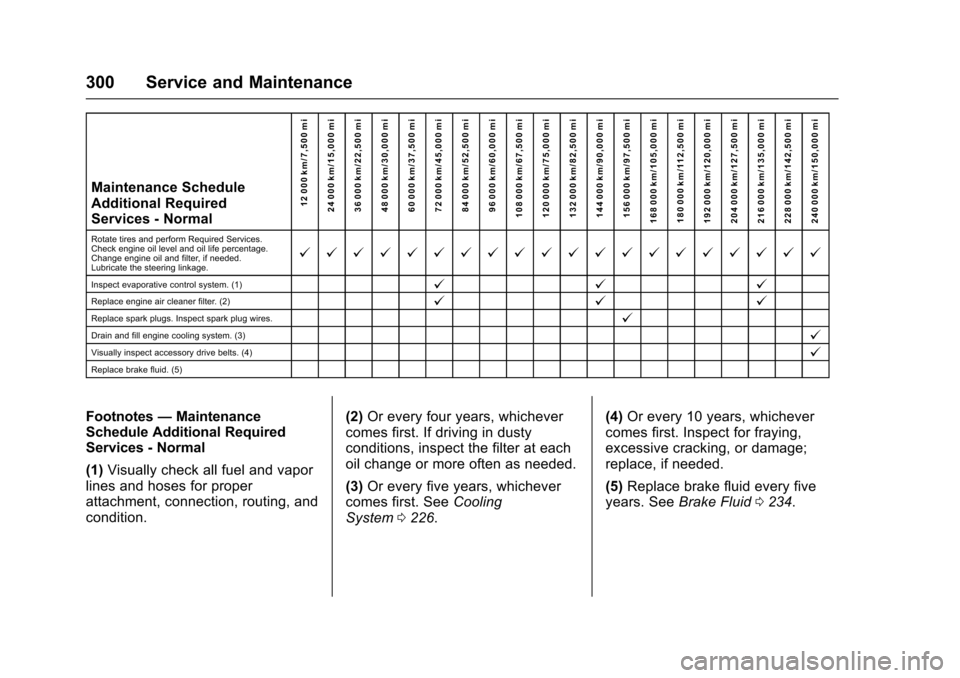
Chevrolet Express Owner Manual (GMNA-Localizing-U.S./Canada/Mexico-9967827) - 2017 - crc - 5/2/16
300 Service and Maintenance
Maintenance ScheduleAdditional RequiredServices - Normal
12 000 km/7,500 mi24 000 km/15,000 mi36 000 km/22,500 mi48 000 km/30,000 mi60 000 km/37,500 mi72 000 km/45,000 mi84 000 km/52,500 mi96 000 km/60,000 mi108 000 km/67,500 mi120 000 km/75,000 mi132 000 km/82,500 mi144 000 km/90,000 mi156 000 km/97,500 mi168 000 km/105,000 mi180 000 km/112,500 mi192 000 km/120,000 mi204 000 km/127,500 mi216 000 km/135,000 mi228 000 km/142,500 mi240 000 km/150,000 mi
Rotate tires and perform Required Services.Check engine oil level and oil life percentage.Change engine oil and filter, if needed.Lubricate the steering linkage.@@@@@@@@@@@@@@@@@@@@
Inspect evaporative control system. (1)@@@
Replace engine air cleaner filter. (2)@@@
Replace spark plugs. Inspect spark plug wires.@
Drain and fill engine cooling system. (3)@
Visually inspect accessory drive belts. (4)@
Replace brake fluid. (5)
Footnotes—MaintenanceSchedule Additional RequiredServices - Normal
(1)Visually check all fuel and vaporlines and hoses for properattachment, connection, routing, andcondition.
(2)Or every four years, whichevercomes first. If driving in dustyconditions, inspect the filter at eachoil change or more often as needed.
(3)Or every five years, whichevercomes first. SeeCoolingSystem0226.
(4)Or every 10 years, whichevercomes first. Inspect for fraying,excessive cracking, or damage;replace, if needed.
(5)Replace brake fluid every fiveyears. SeeBrake Fluid0234.
Page 302 of 346
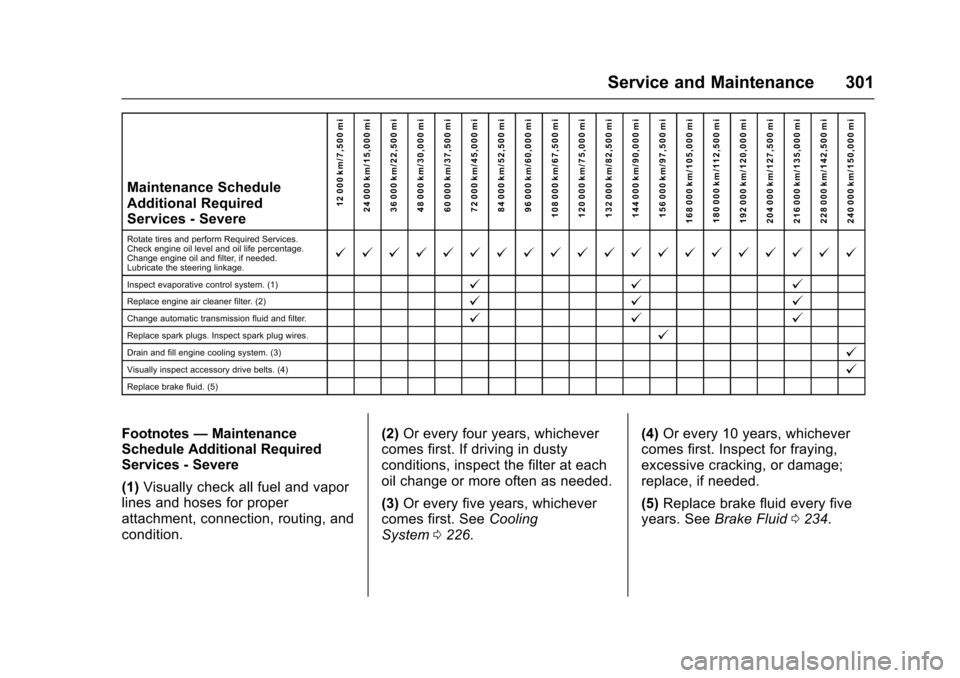
Chevrolet Express Owner Manual (GMNA-Localizing-U.S./Canada/Mexico-9967827) - 2017 - crc - 5/2/16
Service and Maintenance 301
Maintenance ScheduleAdditional RequiredServices - Severe
12 000 km/7,500 mi24 000 km/15,000 mi36 000 km/22,500 mi48 000 km/30,000 mi60 000 km/37,500 mi72 000 km/45,000 mi84 000 km/52,500 mi96 000 km/60,000 mi108 000 km/67,500 mi120 000 km/75,000 mi132 000 km/82,500 mi144 000 km/90,000 mi156 000 km/97,500 mi168 000 km/105,000 mi180 000 km/112,500 mi192 000 km/120,000 mi204 000 km/127,500 mi216 000 km/135,000 mi228 000 km/142,500 mi240 000 km/150,000 mi
Rotate tires and perform Required Services.Check engine oil level and oil life percentage.Change engine oil and filter, if needed.Lubricate the steering linkage.@@@@@@@@@@@@@@@@@@@@
Inspect evaporative control system. (1)@@@
Replace engine air cleaner filter. (2)@@@
Change automatic transmission fluid and filter.@@@
Replace spark plugs. Inspect spark plug wires.@
Drain and fill engine cooling system. (3)@
Visually inspect accessory drive belts. (4)@
Replace brake fluid. (5)
Footnotes—MaintenanceSchedule Additional RequiredServices - Severe
(1)Visually check all fuel and vaporlines and hoses for properattachment, connection, routing, andcondition.
(2)Or every four years, whichevercomes first. If driving in dustyconditions, inspect the filter at eachoil change or more often as needed.
(3)Or every five years, whichevercomes first. SeeCoolingSystem0226.
(4)Or every 10 years, whichevercomes first. Inspect for fraying,excessive cracking, or damage;replace, if needed.
(5)Replace brake fluid every fiveyears. SeeBrake Fluid0234.